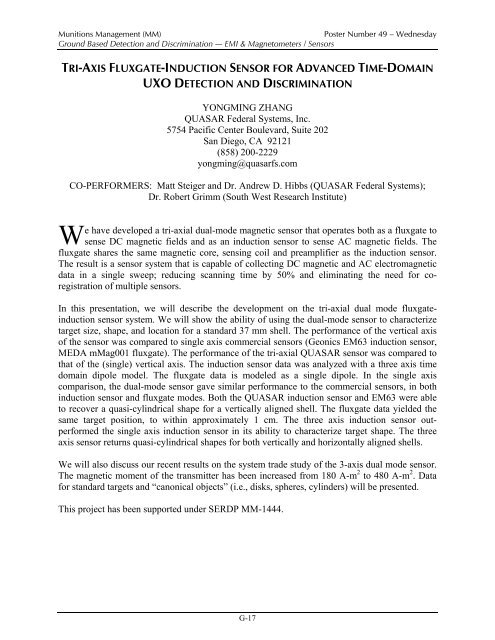Wednesday (Group 2) - SERDP-ESTCP - Strategic Environmental ...
Wednesday (Group 2) - SERDP-ESTCP - Strategic Environmental ...
Wednesday (Group 2) - SERDP-ESTCP - Strategic Environmental ...
Create successful ePaper yourself
Turn your PDF publications into a flip-book with our unique Google optimized e-Paper software.
Munitions Management (MM)<br />
Poster Number 49 – <strong>Wednesday</strong><br />
Ground Based Detection and Discrimination — EMI & Magnetometers / Sensors<br />
TRI-AXIS FLUXGATE-INDUCTION SENSOR FOR ADVANCED TIME-DOMAIN<br />
UXO DETECTION AND DISCRIMINATION<br />
YONGMING ZHANG<br />
QUASAR Federal Systems, Inc.<br />
5754 Pacific Center Boulevard, Suite 202<br />
San Diego, CA 92121<br />
(858) 200-2229<br />
yongming@quasarfs.com<br />
CO-PERFORMERS: Matt Steiger and Dr. Andrew D. Hibbs (QUASAR Federal Systems);<br />
Dr. Robert Grimm (South West Research Institute)<br />
W<br />
e have developed a tri-axial dual-mode magnetic sensor that operates both as a fluxgate to<br />
sense DC magnetic fields and as an induction sensor to sense AC magnetic fields. The<br />
fluxgate shares the same magnetic core, sensing coil and preamplifier as the induction sensor.<br />
The result is a sensor system that is capable of collecting DC magnetic and AC electromagnetic<br />
data in a single sweep; reducing scanning time by 50% and eliminating the need for coregistration<br />
of multiple sensors.<br />
In this presentation, we will describe the development on the tri-axial dual mode fluxgateinduction<br />
sensor system. We will show the ability of using the dual-mode sensor to characterize<br />
target size, shape, and location for a standard 37 mm shell. The performance of the vertical axis<br />
of the sensor was compared to single axis commercial sensors (Geonics EM63 induction sensor,<br />
MEDA mMag001 fluxgate). The performance of the tri-axial QUASAR sensor was compared to<br />
that of the (single) vertical axis. The induction sensor data was analyzed with a three axis time<br />
domain dipole model. The fluxgate data is modeled as a single dipole. In the single axis<br />
comparison, the dual-mode sensor gave similar performance to the commercial sensors, in both<br />
induction sensor and fluxgate modes. Both the QUASAR induction sensor and EM63 were able<br />
to recover a quasi-cylindrical shape for a vertically aligned shell. The fluxgate data yielded the<br />
same target position, to within approximately 1 cm. The three axis induction sensor outperformed<br />
the single axis induction sensor in its ability to characterize target shape. The three<br />
axis sensor returns quasi-cylindrical shapes for both vertically and horizontally aligned shells.<br />
We will also discuss our recent results on the system trade study of the 3-axis dual mode sensor.<br />
The magnetic moment of the transmitter has been increased from 180 A-m 2 to 480 A-m 2 . Data<br />
for standard targets and “canonical objects” (i.e., disks, spheres, cylinders) will be presented.<br />
This project has been supported under <strong>SERDP</strong> MM-1444.<br />
G-17

















